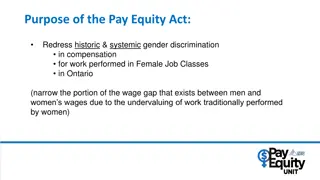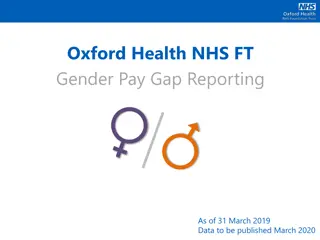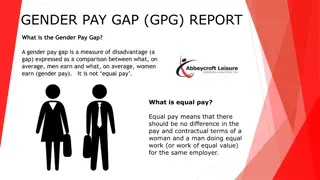Gender Pay Gap Trends and Causes
The gender pay gap remains a critical issue worldwide, impacting gender equality. OECD research highlights trends, causes such as horizontal and vertical segregation, gender stereotypes, and unequal division of unpaid work. Action is needed to address this gap for a more equitable society.
Download Presentation

Please find below an Image/Link to download the presentation.
The content on the website is provided AS IS for your information and personal use only. It may not be sold, licensed, or shared on other websites without obtaining consent from the author.If you encounter any issues during the download, it is possible that the publisher has removed the file from their server.
You are allowed to download the files provided on this website for personal or commercial use, subject to the condition that they are used lawfully. All files are the property of their respective owners.
The content on the website is provided AS IS for your information and personal use only. It may not be sold, licensed, or shared on other websites without obtaining consent from the author.
E N D
Presentation Transcript
International Conference Equal Care and Equal Pay It is high time to close the gaps! 7 September 2022 The gender pay gap: trends, causes and policy responses Valentina Patrini OECD Social Policy Analyst
The gender pay gap: a key issue for gender equality Priority 1 Priority 2 Priority 3 Indicated but not ranked Violence against women Gender pay gap Women's underrepresentation in politics and business Gender stereotypes and prejudice Unequal division of household tasks Women's higher likelihood of poverty Women's lower pensions Others Men's lower life expectancy Boys' higher dropout rates in education 0 5 10 15 20 25 30 35 Note: The 2021 Gender Equality Questionnaire asked Adherents to select the priority issues in gender equality in their country from a list of topics. Number of responses: 41, of which 1 did not identify priority 3, and 1 identified two items as priority 3. Source: 2021 Gender Equality Questionnaire, referred to in OECD (2022), Report on the implementation of the OECD gender recommendations, https://www.oecd.org/mcm/Implementation-OECD-Gender-Recommendations.pdf
The OECD average gender wage gap has decreased over the last 25 years Gender wage gap (%) for full-time dependent employees at the median 25 19.218.9 18.718.418.1 17.9 17.7 20 16.916.516.015.7 14.9 14.914.4 15 13.6 13.5 13.6 13.4 13.5 13.8 13.212.7 12.8 12.6 11.7 10 5 0 1995 2000 2005 2010 2015 2020 Note: Values represent for full-time workers at the median the difference between the earnings of men and of women relative to the earnings of men. OECD average presents the unweighted average of the latest data across all OECD countries. Source: OECD (2022), Gender wage gap indicator https://data.oecd.org/earnwage/gender-wage-gap.htm
Women make about 88 cents for every mans euro, on average, across OECD countries Gender wage gap (%) for full-time dependent employees at median, bottom 10% and top 10% of earnings Note: Values represent for full-time workers at the median the difference between the earnings of men and of women relative to the earnings of men, 2021 or more recent year. OECD average presents the unweighted average of the latest data across all OECD countries. Source: OECD (2022), Gender wage gap indicator https://data.oecd.org/earnwage/gender-wage-gap.htm
What causes the gender pay gap? > Horizontal segregation > Vertical segregation > Gender stereotypes and discrimination > Unequal sharing of unpaid work hours, motherhood penalty > More insights from OECD research using matched employer-employee data
Differences in pay policies between firms account for about 1/4 of the gender wage gap Decomposition of gender wage gap between similarly-qualified women and men within and between firms Between firm Within firm 0.05 0 -0.05 -0.1 -0.15 -0.2 -0.25 -0.3 -0.35 -0.4 -0.45 -0.5 Note: The wage gap between similarly skilled women and men is obtained from a regression of log wages on a gender dummy and flexible earnings-experience profiles as well as education (education is not available for Austria and Estonia) and decade-of-birth dummies to control for cohort effects. Source: OECD (2021), The Role of Firms in Wage Inequality: Policy Lessons from a Large Scale Cross-Country Study, OECD Publishing, Paris, https://dx.doi.org/10.1787/7d9b2208-en
The gender wage gap increases over the life course, particularly after having children Wage loss following a career break by skill (wage tercile) > Within firms: differences in the incidence of promotions. > Between firms: differences in the nature of job mobility. > Career breaks around the age of childbirth account for a large fraction of the motherhood penalty > Much of all this can be attributed to the unequal sharing of unpaid work hours between parents. Note: Sample: Women aged 25 to 34 (different reference periods across countries). Source: OECD (2021), The Role of Firms in Wage Inequality: Policy Lessons from a Large Scale Cross-Country Study https://dx.doi.org/10.1787/7d9b2208-en
Policy implications: A comprehensive approach is needed > Education: access, attainment and choices > Family policies: > Parental leave policies > Early childhood and education > Financial incentives > Labour market policies and policies targeted at firms: > Equal pay laws and anti-discrimination laws > Wage-setting institutions > Pay transparency measures > Quotas, voluntary target-setting and soft measures to break the glass ceiling
OECD sources and publications on the gender pay gap > OECD (forthcoming, September 2022), The gender wage gap in Germany and the role of firms: new evidence and policy lessons, OECD Publishing, Paris. > OECD Family Database https://www.oecd.org/els/family/database.htm. > OECD (2022), Report on the implementation of the OECD gender recommendations, OECD, https://www.oecd.org/mcm/Implementation-OECD-Gender-Recommendations.pdf. > OECD (2021), Pay Transparency Tools to Close the Gender Wage Gap, OECD Publishing, Paris, https://dx.doi.org/10.1787/eba5b91d-en. > OECD (2021), The Role of Firms in Wage Inequality: Policy Lessons from a Large Scale Cross-Country Study, OECD Publishing, Paris, https://dx.doi.org/10.1787/7d9b2208-en.
Thank you! Valentina.Patrini@oecd.org Email me @OECD_Social Follow us on Twitter http://oe.cd/fdb // http://oe.cd/fdb-fr http://oe.cd/gender // www.oecd.org/fr/parite Visit our website

 undefined
undefined

























